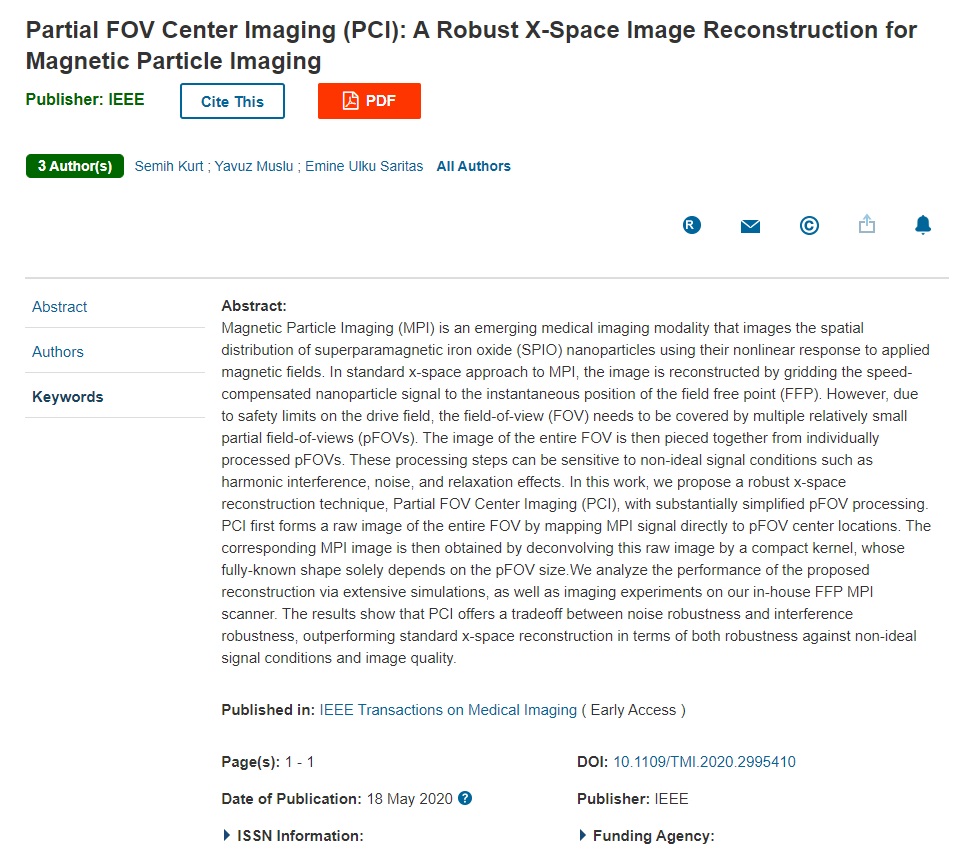Semih Kurt, Yavuz Muslu ve Emine Ülkü Sarıtaş, IEEE Tıbbi Görüntüleme İşlemlerinde “Kısmi FOV Merkezi Görüntüleme (PCI): Manyetik Parçacık Görüntülemesi için Sağlam Bir X-Uzay Görüntüsü Rekonstrüksiyonu" başlıklı bir makale yayınladı. Manyetik Parçacık Görüntüleme (MPI), uygulanan manyetik alanlara doğrusal olmayan tepkilerini kullanarak süperparamanyetik demir oksit (SPIO) nanoparçacıkların uzamsal dağılımını görüntüleyen, ortaya çıkan tıbbi bir görüntüleme yöntemidir. Bu çalışmada, büyük ölçüde basitleştirilmiş işlem adımları ile Kısmi FOV Merkezi Görüntüleme (PCI) adı verilen sağlam bir x-uzay görüntü rekonstrüksiyon tekniği önerilmiştir. UMRAM’deki şirket içi MPI tarayıcı üzerinde kapsamlı simülasyonlar ve görüntüleme deneyleri, PCI’nin gürültü sağlamlığı ve parazit sağlamlığı arasında bir denge sunduğunu ve ideal olmayan sinyal koşullarına ve görüntü kalitesine karşı sağlamlık açısından standart x-uzay rekonstrüksiyonunu geride bıraktığını gösteriyor.
Abstract:
Magnetic Particle Imaging (MPI) is an emerging medical imaging modality that images the spatial distribution of superparamagnetic iron oxide (SPIO) nanoparticles using their nonlinear response to applied magnetic fields. In standard x-space approach to MPI, the image is reconstructed by gridding the speed-compensated nanoparticle signal to the instantaneous position of the field free point (FFP). However, due to safety limits on the drive field, the field-of-view (FOV) needs to be covered by multiple relatively small partial field-of-views (pFOVs). The image of the entire FOV is then pieced together from individually processed pFOVs. These processing steps can be sensitive to non-ideal signal conditions such as harmonic interference, noise, and relaxation effects. In this work, we propose a robust x-space reconstruction technique, Partial FOV Center Imaging (PCI), with substantially simplified pFOV processing. PCI first forms a raw image of the entire FOV by mapping MPI signal directly to pFOV center locations. The corresponding MPI image is then obtained by deconvolving this raw image by a compact kernel, whose fully-known shape solely depends on the pFOV size.We analyze the performance of the proposed reconstruction via extensive simulations, as well as imaging experiments on our in-house FFP MPI scanner. The results show that PCI offers a tradeoff between noise robustness and interference robustness, outperforming standard x-space reconstruction in terms of both robustness against non-ideal signal conditions and image quality.
